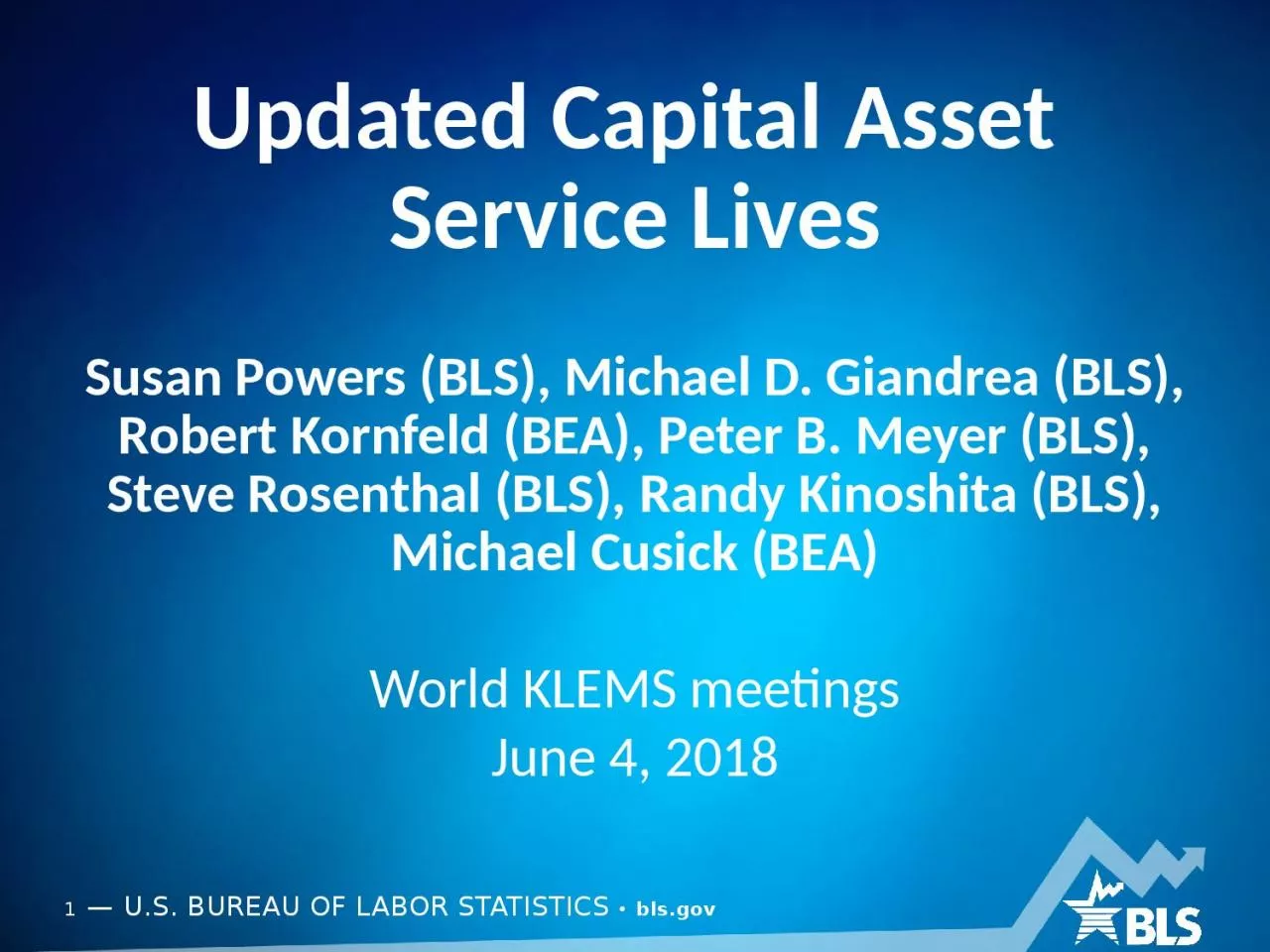

Susan Powers BLS Michael D Giandrea BLS Robert Kornfeld BEA Peter B Meyer BLS Steve Rosenthal BLS Randy Kinoshita BLS Michael Cusick BEA World KLEMS meetings June 4 2018 ID: 1044602
Download Presentation The PPT/PDF document "Updated Capital Asset Service Lives" is the property of its rightful owner. Permission is granted to download and print the materials on this web site for personal, non-commercial use only, and to display it on your personal computer provided you do not modify the materials and that you retain all copyright notices contained in the materials. By downloading content from our website, you accept the terms of this agreement.
1. Updated Capital Asset Service LivesSusan Powers (BLS), Michael D. Giandrea (BLS), Robert Kornfeld (BEA), Peter B. Meyer (BLS), Steve Rosenthal (BLS), Randy Kinoshita (BLS), Michael Cusick (BEA)World KLEMS meetingsJune 4, 2018
2. Need for service life estimatesProductive capital = structures, equipment, softwareDirect measures of capital stocks are not availablePerpetual Inventory Method (PIM) makes estimates of capital stock by industry from past investmentService lives assumed to be distributed symmetrically around reported average age (haystack distribution)Adjust past investment for deterioration using an age-efficiency function (BLS-hyperbolic and BEA-geometric)Aggregate efficiency-adjusted investments over time into a productive capital stock in each period
3. Sources of current asset service livesBureau of Economic Analysis provides BLS with depreciation rates for asset categories.Sources:Hulten and Wykoff (1979, 1981a, 1981b)U.S. Treasury Bulletin F (1942)IRS/Treasury Office of Industrial Economics (1970s)Treasury Office of Tax Analysis (1980s and 1990s)
4. Establishment survey by Statistics CanadaAnnual Capital and Repair Expenditures SurveyOngoing survey since 1980sData includesExpenditures on 155 asset typesExpected service lives of new assetsSelling prices and ages of disposed assets / discardsUsed asset sales and discardsLarge sample of service lives and depreciation rates
5. Canada’s Annual Capital and Repair Expenditures Survey
6. Canadian service lives and depreciation rates for construction
7. Canadian service lives and depreciation rates for equipment
8. US – Canada concordanceNeeded a concordance between US and Canadian asset categories to map Canadian service lives to US asset categoriesBLS and BEA worked together to construct a concordanceBEA documentation on the definitions of fixed investment expenditure categories used in developing concordance
9. US – Canada concordance
10. US – Canada concordanceStatistics Canada asset categories more detailed than US typically. In some cases, multiple Canadian categories are combined into one U.S. category BEA nominal fixed investment data used to weight depreciation rates and develop single rate
11. Comparison of US and Canadian lives
12. US and Canadian lives - structures
13. Testing new service livesBLS re-computes depreciation through hyperbolic; BEA through geometricChallenging to compute stocks from an existing asset base whose lives changed2 possible models of changing service life:Service lives change for all assets because new substitutes available or standards to be metService lives changed for newly created assets
14. Effects of revised service livesBEA and BLS evaluated capital stocks scenarios with the revised SC depreciation rates:The first adopted the new rates from the start of the investment time series – 1901The second implemented the new rates beginning in 1985, assuming services lives had changed
15. Comparison of existing and revised capital stocks – BEA
16. Comparison of existing and revised capital stocks – BLS
17. Comparison of existing and revised growth rates of the capital stock
18. Effects of revised service lives on MFP
19. ConclusionsThe revised depreciation rates have a substantial downward impact on capital stock levels and growth rate trendsFor most assets, the updated service life data has little impact on estimated capital services and MFP growth rates
20. BLS and BEA Future PlansUse Canadian depreciation rates as guidance for revising current US depreciation rates and related BEA and BLS service livesDevelop and jointly propose a set of new U.S depreciation rates in the near future
21. Internal and External Rates of ReturnBLSMichael D. Giandrea Peter MeyerSusan Powers Steve Rosenthal Brian Chansky Randy KinoshitaJune 4, 2018
22. Rate of returnThe rate of return, rit , represents how many dollars of income are generated per $100 of physical capital assetsEffort underway to standardize methodology across major sector and industry studies divisionsIRR = Internal Rate of ReturnERR = External Rate of Return
23. Rate of return – Industry DivisionUses a simplified version of the IRR formulaCapital compensation CCitCapital stock kitAsset price deflator ptTax parameter Asset depreciation dt
24. Rate of return – Industry DivisionCalculates IRR for 88 industries (primarily 4-digit)Must first generate estimates of capital income by detailed industryCapital income is industry output less value of labor and intermediate purchases
25. Major Sector and Industry DivisionsBoth calculate IRR at the industry levelMajor Sector: at the NIPA industry levelIndustry Division: 4-digit NAICS industry levelDifferent measures of capital incomeMajor Sector: uses BEA corporate capital income and proprietors’ income dataIndustry Division: estimates capital income as an industry residual
26. Industry Division – External rate of returnFocus is not on whether IRR is negativeInstead, look for negative detailed asset rental prices which can occur for many reasonsLow capital income levelsNegative IRRsHigh capital gains
27. Industry Division – Use of ERRIf the rental price for an industry is negative, substitute an ERR of 3.5%If rental price for ANY asset calculated with an IRR is negative, the ERR is used for ALL assets in that industry in that yearIndustry Division also omits the capital gains term for the rental price calculation when using the ERRThis change is only for the single year
28. Upcoming changes – Industry DivisionCalculate and use an ERR based on the Industry Division’s manufacturing sector IRRRequires evaluation of change to assess effect on rental prices and capital measures compared to current approachAdjust the new ERRs such that industry sectoral output equals value of capital, labor and intermediate inputs, by industry
29. Questions